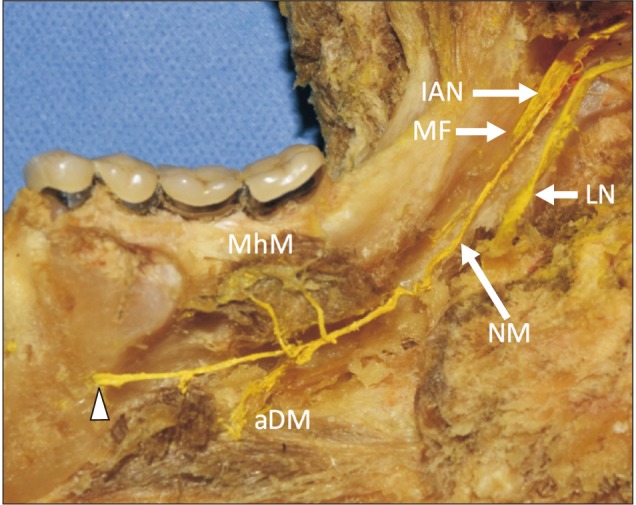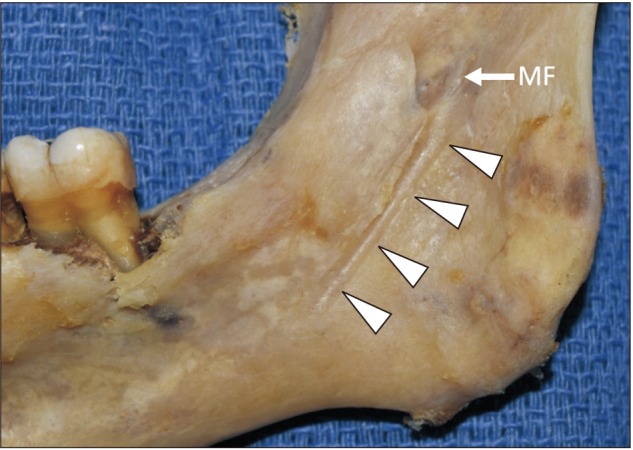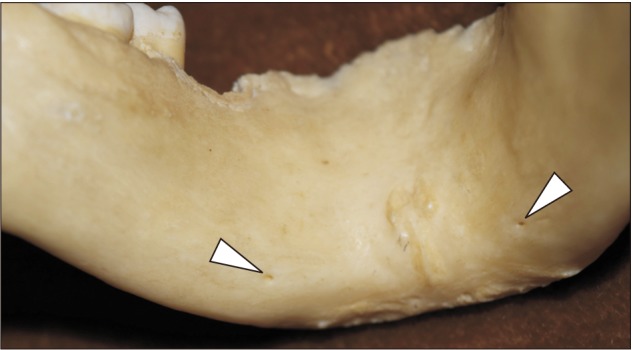1. Bennett S, Townsend G. Distribution of the mylohyoid nerve: anatomical variability and clinical implications. Aust Endod J. 2001; 27:109–111. PMID:
12360663.
2. Adjei SS, Hammersley N. Mylohyoid nerve damage due to excision of the submandibular salivary gland. Br J Oral Maxillofac Surg. 1989; 27:209–211. PMID:
2742806.
3. Potu BK, D'Silva SS, Thejodhar P, Jattanna NC. An unusual communication between the mylohyoid and lingual nerves in man: its significance in lingual nerve injury. Indian J Dent Res. 2010; 21:141–142. PMID:
20427927.
4. Oth O, Louryan S, Van Sint Jan S, Rooze M, Glineur R. Impact of the mandibular divergence on the position of the inferior alveolar nerve and mylohyoid nerve: a computed tomography study and its relevance to bilateral sagittal split osteotomy. Surg Radiol Anat. 2013; 35:241–247. PMID:
22926343.
5. Stein P, Brueckner J, Milliner M. Sensory innervation of mandibular teeth by the nerve to the mylohyoid: implications in local anesthesia. Clin Anat. 2007; 20:591–595. PMID:
17352413.
6. Frommer J, Mele FA, Monroe CW. The possible role of the mylohyoid nerve in mandibular posterior tooth sensation. J Am Dent Assoc. 1972; 85:113–117. PMID:
4503581.
7. Altug HA, Sencimen M, Varol A, Kocabiyik N, Dogan N, Gulses A. The efficacy of mylohyoid nerve anesthesia in dental implant placement at the edentulous posterior mandibular ridge. J Oral Implantol. 2012; 38:141–147. PMID:
20662675.
8. Madeira MC, Percinoto C, das Gracas MS. Clinical significance of supplementary innervation of the lower incisor teeth: a dissection study of the mylohyoid nerve. Oral Surg Oral Med Oral Pathol. 1978; 46:608–614. PMID:
280855.
9. Madhyastha S, Prabhu LV, Saralaya VV, Nayak SR, D'Costa S, Acharya A. Dual innervations of mylohyoid muscle: a case report. Rom J Morphol Embryol. 2009; 50:305–306. PMID:
19434328.
10. Sutton RN. The practical significance of mandibular accessory foramina. Aust Dent J. 1974; 19:167–173. PMID:
4530720.
11. Chapnick L. Nerve supply to the mandibular dentition: a review. J Can Dent Assoc. 1980; 46:446–448. PMID:
6992957.
12. Heasman PA, Beynon AD. The role of the mylohyoid nerve in mandibular tooth innervation. J Dent. 1986; 14:80–81. PMID:
3469244.
13. Blanton PL, Jeske AH. ADA Council on Scientific Affairs. ADA Division of Science. The key to profound local anesthesia: neuroanatomy. J Am Dent Assoc. 2003; 134:753–760. PMID:
12839412.
14. Hwang K, Han JY, Chung IH, Hwang SH. Cutaneous sensory branch of the mylohyoid nerve. J Craniofac Surg. 2005; 16:343–345. PMID:
15915093.
15. Standring S. Gray's anatomy: the anatomical basis of clinical practice. 41st ed. London: Elsevier Health Sciences;2015.
16. Valentin G. Traité de neurologie. Paris: JB Bailliére;1843.
17. Fujii H, Fujita A, Yang A, Kanazawa H, Buch K, Sakai O, Sugimoto H. Visualization of the peripheral branches of the mandibular division of the trigeminal nerve on 3D double-echo steady-state with water excitation sequence. AJNR Am J Neuroradiol. 2015; 36:1333–1337. PMID:
25836724.
18. Heasman PA, Beynon AD. Quantitative and spectrum analysis of human mylohyoid nerves. J Anat. 1987; 151:45–49. PMID:
3654359.
19. Clark S, Reader A, Beck M, Meyers WJ. Anesthetic efficacy of the mylohyoid nerve block and combination inferior alveolar nerve block/mylohyoid nerve block. Oral Surg Oral Med Oral Pathol Oral Radiol Endod. 1999; 87:557–563. PMID:
10348512.
20. He P, Truong MK, Adeeb N, Tubbs RS, Iwanaga J. Clinical anatomy and surgical significance of the lingual foramina and their canals. Clin Anat. 2017; 30:194–204. PMID:
28033685.
21. Wilson S, Johns P, Fuller PM. The inferior alveolar and mylohyoid nerves: an anatomic study and relationship to local anesthesia of the anterior mandibular teeth. J Am Dent Assoc. 1984; 108:350–352. PMID:
6585407.
22. Kumar S, Kumar CJ, Bhat S, Kumar A. Anatomical study of the unusual origin of a nerve to the mylohyoid muscle and its clinical relevance. Br J Oral Maxillofac Surg. 2011; 49:e14–e15. PMID:
20813441.
23. Tubbs RS, Shoja MM, Loukas M. Bergman's comprehensive encyclopedia of human anatomic variation. Hobojken, NJ: John Wiley & Sons;2016.
24. Sinha P, Tamang BK, Sarda RK. Communication between mylohyoid and lingual nerve: an anatomical variation. J Clin Diagn Res. 2014; 8:AD01–AD02.
25. Sato I, Sunohara M, Ueno R, Yoshida S. Branch of mylohyoid and lingual nerves on submandibular and submental triangles. Okajimas Folia Anat Jpn. 2004; 81:45–48. PMID:
15455728.
26. Kameda K, Über den N. mandibularis bei Japanern. Acta Inst Anat Niigataensis. 1952; 28:1–24.
27. Varol A, Sencimen M, Kocabiyik N, Gulses A, Ozan H. Clinical and anatomical aspects of possible mylohyoid nerve injury during genioplasties. Int J Oral Maxillofac Surg. 2009; 38:1084–1087. PMID:
19625167.
28. Narayana K, Narayan P, Ashwin K, Prabhu LV. Incidence, types and clinical implications of a non-metrical variant: mylohyoid bridging in human mandibles. Folia Morphol (Warsz). 2007; 66:20–24. PMID:
17533590.
29. Iwanaga J, Watanabe K, Saga T, Tubbs RS, Tanaka K, Kikuta S, Tabira Y, Fisahn C, Kamura Y, Kusukawa J, Yamaki KI. A Novel method for observation of the mandibular foramen: application to a better understanding of dental anatomy. Anat Rec (Hoboken). 2017; 300:1875–1880. PMID:
28681490.
30. Nikolova SY, Toneva DH, Yordanov YA, Lazarov NE. Morphometric study of the mylohyoid bridging in dry mandibles. Anthropol Anz. 2017; 74:113–122. PMID:
28485753.
31. Mensink G, Gooris PJ, Bergsma EJ, Frank MH, van Gemert JT, van Merkesteyn JP. Is the lingual fracture line influenced by the mandibular canal or the mylohyoid groove during a bilateral sagittal split osteotomy? A human cadaveric study. J Oral Maxillofac Surg. 2014; 72:973–979. PMID:
24326018.
32. Hosapatna M, Ankolekar VH, D'Souza AS, Deepika C, D'Souza A. The study of antilingula and its relation to the lingula and mandibular foramen, the presence of mylohyoid bridging in dry mandibles of South Indian population. J Maxillofac Oral Surg. 2015; 14:308–311.
33. Fabian FM. Observation of the position of the lingula in relation to the mandibular foramen and the mylohyoid groove. Ital J Anat Embryol. 2006; 111:151–158. PMID:
17312921.
34. Iwanaga J, Nakamura Y, Abe Y, Kikuta S, Iwamoto O, Kusukawa J. Multiple accessory foramina of the mandibular ramus: risk factor for oral surgery. Surg Radiol Anat. 2016; 38:877–880. PMID:
26780777.
35. Guyot L, Layoun W, Richard O, Cheynet F, Gola R. Alteration of chin sensibility due to damage of the cutaneous branch of the mylohyoid nerve during genioplasty. J Oral Maxillofac Surg. 2002; 60:1371–1373. PMID:
12420278.
36. Tubbs RS, Loukas M, Shoja MM, Acakpo-Satchivi L, Wellons JC 3rd, Blount JP, Oakes WJ. The nerve to the mylohyoid as a donor for facial nerve reanimation procedures: a cadaveric feasibility study. J Neurosurg. 2007; 106:677–679. PMID:
17432721.
37. Marinho RO, Tennant CJ. Paresthesia of the cutaneous branch of the mylohyoid nerve after removal of a submandibular salivary gland. J Oral Maxillofac Surg. 1997; 55:170–171. PMID:
9024355.





 PDF
PDF ePub
ePub Citation
Citation Print
Print





 XML Download
XML Download